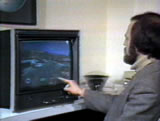Inhaltliche Beschreibung
MOVIEMAPS
Moviemaps allow virtual travel through pre-recorded spaces. Routes are pre-determined and filmed with a stop-frame camera triggered by distance rather than by time (typically done via an encoder on a wheel). Distance-triggering maintains constant speeds during playback at constant frame rates, which is often not practical or possible during production with a conventional (time-triggered) movie camera. The result, in a very real sense, is the transfer of speed control from the producer to the end-user, who has control over frame rate through an input device like a joystick or trackball.
In addition to speed control, limited control of direction is possible by filming registered turns at intersections. By match-cutting between a straight sequence and a turn sequence, the user can "move" from one route to another. Care must be taken to minimize visual discontinuities such as sun position and transient objects (e.g., cars and people). The goal is to make the cuts appear as seamless as possible.
FIRST INTERACTIVE MOVIEMAP
The first interactive moviemap was produced at MIT in the late 1970s of Aspen, Colorado. A gyroscopic stabilizer with 16mm stop-frame cameras was mounted on top of a camera car and a fifth wheel with an encoder triggered the cameras every 10 feet. Filming took place daily between 10 AM and 2 PM to minimize lighting discrepancies. The camera car carefully drove down the center of the street for registered match-cuts. In addition to the basic "travel" footage, panoramic camera experiments, thousands of still frames, audio, and data were collected. The playback system required several laserdisc players, a computer, and a touch screen display. Very wide-angle lenses were used for filming, and some attempts at orthoscopic playback were made. (see: R. Mohl, Cognitive Space in the Interactive Movie Map: An Investigation of Spatial Learning in Virtual Environments, PhD dissertation, Education and Media Technology, M.I.T., 1981.)
(M. Naimark)


